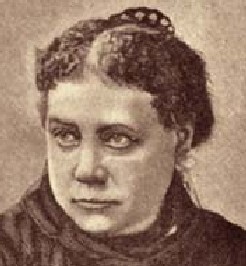Theosophical Society,

H P Blavatsky
The Puranas on the
Dynasty of the Moryas
and on Koot Hoomi
By
R. Ragoonath Row
This article was published in the
Theosophist and includes a detailed editors
note
It
is stated in Matsya Puran, chapter cclxxii., that ten
Moryas would
reign over
Dhanva
will be the first of these ten Maureyas (or Moryas).
In
Vishnu Purana (Book IV. chapter iv.) it is stated that there was in
the Soorya dynasty a king called Moru, who through
the power of devotion
(Yoga)
is said to be still living in the village called Katapa, in the
will be the restorer of the Kshatriya race, in the
Solar dynasty, that
is, many thousands of years hence. In another part of the same Purana
(Book
IV. chapter xxiv.) it is stated that, "upon the
cessation of the
race of Nanda, the Moryas* will possess the earth,
for Kautilya will
place Chandragupta on the throne." Col. Tod considers Morya, or Maurya,
a corruption of Mori, the name of a Rajput tribe.
NOTE
* The particulars of
this legend are recorded in the Atthata katha of
the Uttaraviharo priests.
The
Commentary on the Mahavanso thinks that the princes of the town Mori
were thence called Mauryas. Vachaspattya, a Sanskrit Encyclopaedia,
places the
hence in
Bhagavat, vol. iii. p.
325. The Vayu Purana seems to
declare that Moru
will re-establish the Kshatriyas in the nineteenth
coming Yuga. In
chapter vi. Book III. of
Vishnu Purana, a Rishi called Koothoomi is
mentioned.
Will any of our Brothers tell us how our Mahatmas stand to
these revered personages?
--R.
Ragoonath Row
Editor's
Note
In
the Buddhist Mahavanso, Chandagatto, or Chandragupta, Asoka's
grandfather, is called a prince of the Moryan
dynasty as he certainly
was--or rather as they were, for there were several
Chandraguptas. This
dynasty, as said in the same book, began with
certain Kshatriyas
(warriors) of the Sakya line closely related to Gautama
Buddha, who
crossing the Himavanto (
well watered, and situated in the midst of a forest
of lofty bo and
other trees.
There they founded a town, which was called by its Sakya
lords, Morya-Nagara." Prof. Max Muller would see in this legend a
made-up story for two reasons: (1) A desire on the part of Buddhists to
connect their king Asoka, "the beloved of
gods," with Buddha, and thus
nullify the slanders set up by the Brahmanical
opponents of Buddhism to
the effect that Asoka and Chandragupta were Sudras;
and (2) because this
document does not dovetail with his own theories
and chronology based on
the fanciful stories of the Greek-Megasthenes and
others. It was not
the princes of Morya-Nagara who received their name
from the Rajput
tribe of Mori, but the latter that became so well
known as being
composed of the descendants of the Moryan
sovereign of Morya-Nagara.
Some
light is thrown on the subsequent destiny of that dynasty in
"Replies to an English F.T.S." (See
ante.) The name of Rishi
Koothoomi
is mentioned in more than one Purana, and his Code
is among the eighteen
Codes
written by various Rishis, and preserved at
library of the Asiatic Society. But we have not been told whether there
is any connection between our Mahatma of that name
and the Rishi, and we
do not feel justified in speculating upon the
subject. All we know is,
that both are Northern Brahmans, while the Moryas
are Kshatriyas. If
any of our Brothers know more, or can discover
anything relating to the
subject in the Sacred Books, we shall hear of it
with pleasure. The
words:
"The Moryas will possess the earth, for Kautilya will place
Chandragupta
on the throne," have in our occult philosophy a
dual
meaning.
In one sense they relate to the days of early Buddhism, when a
Chandragupta
(Morya) was the king "of all the earth," i.e., of Brahmans,
who believed themselves the highest and only
representatives of humanity
for whom earth was evolved. The second meaning is
purely esoteric.
Every
adept or genuine Mahatma is said to "possess the earth," by the
power of his occult knowledge. Hence, a series of ten Moryas, all
initiated adepts, would be regarded by the
occultists, and referred to
as "possessing all the earth," or all
its knowledge. The names of
"Chandragupta"
and "Kautilya" have also an esoteric significance. Let
our Brother ponder over their Sanskrit meaning, and
he will perhaps see
what bearing the phrase--"for Kautilya will
place Chandragupta upon the
throne"--has upon the Moryas possessing the
earth. We would also remind
our Brother that the word Itihasa, ordinarily
translated as "history,"
is defined by Sanskrit authorities to be the
narrative of the lives of
some August personages, conveying at the same time
meanings of the
highest moral and occult importance.
Theosophical Society,